Varicose veins can appear in different parts of the body, but the most common are varicose veins of the lower limbs. This disease is characterized by a violation of the outflow of blood, which stagnates in the veins of the legs. In medicine, varicose veins of the lower limbs are interpreted as a disease that is accompanied by an increase in length, the appearance of serpentine bends of the saphenous veins, and a sac-like growth of their lumen. The disease occurs in 17-25% of the population. In addition, women are affected by this disease three times more often than men.
Causes of the disease
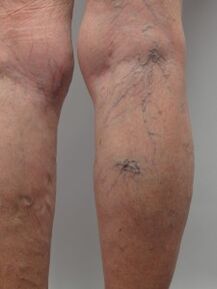
The main causes of the disease are:
- heredity;
- old age;
- overweight;
- wearing tight underwear and uncomfortable, especially narrow, high-heeled shoes.
The effect of heredity on the occurrence and development of varicose veins has not yet been proven. However, it should be noted that it is common for some families to have varicose veins for several generations. It should be noted that the dominant factor in the development of the disease is nutrition, specific lifestyle and changes in the hormonal cycle.
The main risk factor for the development of the disease is obesity, depending on the severity of obesity, the occurrence of varicose veins increases.
Being overweight is associated with a sedentary lifestyle and an improperly organized diet. For example, the modern world is dominated by processed foods and lacks the consumption of plant fibers found in raw vegetables, berries and fruits. Plant fibers are essential for strengthening blood vessel walls and reducing intra-abdominal pressure, which also helps reduce the risk of disease.
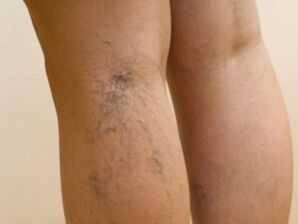
In addition to proper nutrition, the work process must be properly organized. Usually, a person spends considerable working time in a standing or sitting position, which has a bad effect on the functioning of the valve apparatus of the veins. Equally unfavorable is heavy physical work involving heavy loads on the legs when lifting heavy objects. Another risk factor affecting the development of the disease is a long trip or flight, which is associated with the appearance of blood stagnation in the leg veins.
Another pressing cause of the disease is fashion. Thus, tight underwear compresses the veins in the area of the inguinal folds, and the corset significantly increases the intra-abdominal pressure, which leads to the formation of varicose veins. Wearing high heels is extremely harmful, especially in combination with uncomfortable arch supports.
A proven risk factor for venous diseases is repeated pregnancy, which leads to changes in intra-abdominal pressure, while the progesterone hormone has a harmful effect on the walls of the veins, destroying collagen and elastic fibers.
Symptoms of varicose veins of the lower extremities
The main symptoms of this disease are:
- veins protruding from under the skin,
- swelling,
- pain in the legs, especially at night,
- feeling tired
- changes in the appearance of the skin - pigmentation, thickening,
- loss of skin elasticity, hair loss in areas with varicose veins.
The main visible signs of varicose veins are bag-like or cylindrical expansion of the superficial veins. The veins become unnaturally tortuous, rising above the surface of the skin in the legs and feet. The largest varicose veins are recorded after long physical work.
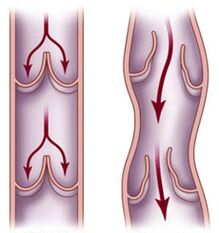
In the first stage of varicose veins, the symptoms are few and non-specific. The only symptom of this stage is a heavy feeling in the legs. Rapid fatigue and a burning sensation in the legs, which is disturbing after physical activity, are also a cause for concern. Sometimes there is short-term swelling and aching pain along the veins. It is characterized by a slight swelling of the back of the foot and ankle, which often occurs in the evening after prolonged monotonous exercise. In the morning, the swelling disappears without a trace, and the visible expansion of the veins is not observed.
If these signs appear, be sure to consult a specialist in time, this will prevent the progression and development of the disease. In the case of inadequate treatment, the neglected situation results in chronic venous insufficiency.
An important symptom of venous insufficiency is spider veins - a network of dilated capillaries (0. 1 mm or more) visible through the skin. Women consider such "stars" as a cosmetic defect, but men simply do not notice them. Sometimes this is just a manifestation of hormonal disorders, abuse of the sauna or solarium. However, in most cases, spider webs are one of the causes of venous congestion and varicose veins. first sign If you have a relatively small area of such a disorder on the skin, be sure to consult a specialist.
Diagnosis of varicose veins
A vascular surgeon can diagnose varicose veins with a routine examination, ultrasound of the veins, and phlebography, which is the injection of special drugs into the vein and monitoring their reaction.
When you see a doctor, a special examination is offered that consists of several procedures.
- Blood test (general), which shows the degree of thickening, blood coagulation (tendency to thrombosis), the presence or absence of inflammation (confirms thrombophlebitis).
- Ultrasound of the veins, which identifies the affected areas. We recommend a vascular ultrasound to identify signs of varicose veins, even if spider veins have already appeared.
- Rheovasography is a method that determines the insufficiency of blood supply (nutrition) to tissues by mathematical calculation. This is how the stage of the disease is determined, which is necessary for the selection of treatment methods.
- Surgical methods, such as venography (see above), are very rarely used to assess the state of the venous system.
Varicose veins treatment methods
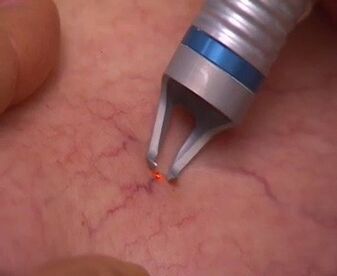
Varicose veins are quite difficult to treat, so prevention is recommended. Conservative treatment methods include special tablets and ointments prescribed by a doctor, as well as wearing stockings and tights with special drawstrings. It is also possible to treat varicose veins surgically, during which the dilated veins are removed from the person using a traction method. Laser therapy and sclerotherapy are considered very effective.
Varicose veins are of great cosmetic concern to patients. Doctors consider it necessary to perform the operation. In order to reduce the risk of complications and speed up recovery, specialists prescribe a special micronized drug that increases the tone of the veins, relieves inflammatory reactions and stimulates lymph flow.
Non-surgical treatment
Treatment of varicose veins without surgery is effective only at the beginning of the disease, if the skin manifestations are mild and moderately reduce the ability to work. If surgical treatment is contraindicated, conservative therapy is performed. This method is also mandatory in the postoperative period in order to prevent recurrence of the disease.
Conservative treatment is as follows:
- reducing the impact of risk factors,
- adequate physical activity,
- flexible compression,
- medicines,
- application of physiotherapy.
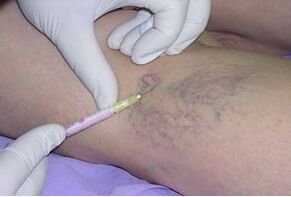
People who have a risk factor for developing varicose veins or have a hereditary predisposition should see a phlebologist twice a year and have an ultrasound examination of their veins.
With conservative treatment, it is necessary to continuously train the veins, to raise the leg for a long time, and to wear only comfortable, comfortable shoes.
Walking will appear, along with swimming or cycling. Physical activity should only be performed under the condition of flexible compression. Elastic compression is a conservative method of treating varicose veins with an elastic bandage or medical knitwear. It is contraindicated to participate in traumatic sports such as football, volleyball and others.
In case of varicose veins, the use of phlebotonic drugs is recommended. The effect of such drugs is aimed at strengthening the walls of the veins.
All folk remedies, including herbs, will never be as effective as pharmaceutical drugs. You should not self-medicate, any drug therapy should only be used as prescribed by a doctor. Local treatment is performed only if there is no thrombosis or thrombophlebitis.
Surgical treatment methods
Complete healing of varicose veins of the lower limbs can only be achieved with surgical treatment.
The following surgical treatment methods are used:
Phlebectomy— varicose vein removal during surgery. This procedure is contraindicated if the patient has a serious co-morbidity or a late stage of varicose veins.
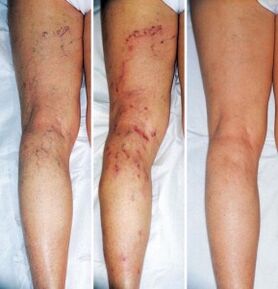 The operation is not performed during pregnancy, the presence of purulent processes in the body or for elderly people.
The operation is not performed during pregnancy, the presence of purulent processes in the body or for elderly people.The use of endoscopic treatment methods makes such an operation as safe and cosmetically beneficial as possible. The set of measures aimed at rapid recovery after surgery depends entirely on the complexity of the surgical procedure, but at the same time takes into account general principles. The final seams are formed after 6 months, therefore, in order to avoid injuries and aesthetic defects, harsh mechanical effects (use of hard sponge, tight, uncomfortable clothing) should be excluded. Do not wash with hot water. Elastic compression must be used for 6 months after surgery. In the future, compression stockings will be needed for "harmful" loads (heavy lifting, long journeys).
Sclerosis- injection of a special substance (sclerosant) into the vein, which causes the venous walls to "stick" and stop the blood flow. In this way, the cosmetic defect is eliminated, as the vein becomes invisible. This method is effective only when expanding the small branches of the main venous trunks. After an intervention for venous sclerosis, patients do not need rehabilitation.
Laser coagulation- the destruction of the vein wall by laser, as a result of which the lumen of the veins is "closed". It is recommended for those whose vein dilation does not exceed 10 mm. The procedure requires anesthesia, early patient activation and long-term flexible compression.
Prevention of varicose veins of the lower limbs
Currently, great importance is attached to the prevention of varicose veins. Simple measures should be taken regularly that can significantly reduce not only the risk of occurrence, but also the development and progression of the disease.
- An active lifestyle, a measured alternation of long static loads with other types of physical activity, such as walking, running, cycling, swimming and simple exercises at work.
- Often keeping the legs in an elevated position.
- Adhering to a diet and monitoring your weight.
- It is helpful if you wear comfortable shoes with a heel of no more than 4 cm and use orthopedic insoles.
- When using estrogens, contraceptives or during pregnancy, an ultrasound examination of the veins of the lower limbs should be performed.
Our health depends only on us, and in order to remain a happy person who is not bothered by any disease, it is important to carefully follow your lifestyle, be physically active and eat right.























